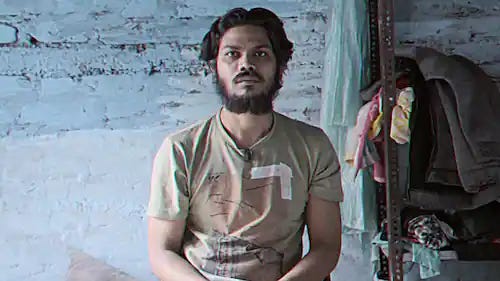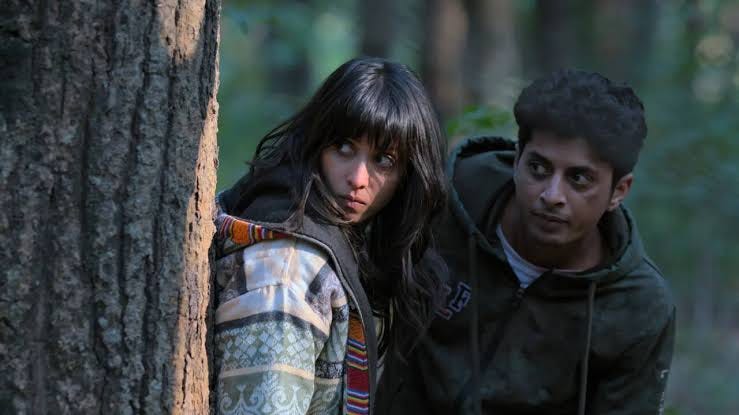Halfway into Black, White & Gray - Love Kills — which sounds like what a name generator would spit out if asked to come up with a slow rock ballad from the Eighties, but is the title of a new crime thriller series on Sony LIV — there’s a twist in the tale. It’s one of many in this show created, written, directed and edited by Pushkar Sunil Mahabal, but this one is pivotal.
For those who want to be surprised at every step, here’s the spoiler-free introduction. Black White & Gray is an investigation into four murders believed to have been committed by one young man, known only as "the accused". It’s fiction that feels unsettlingly real at first. The framing device is a true crime documentary, made by a faceless British freelancer named Daniel Gray (voiced by Edward Sonnenblick). One narrative thread, filmed in a grainy, pale-toned palette, shows the interviews Gray conducts with people related to the case. Running parallel to this is a series of re-enactments, dramatising sequences from the video testimonies. These are shot using more saturated colours as well as smoother textures.
In the re-enactments, we see recognisable faces with excellent performances by Tigmanshu Dhulia (who really should act more), Mayur More, Palak Jaiswal, Deven Bhojwani and Anant Jog. Usually, actors are expected to subsume their off-screen persona into their on-screen role. In Black, White & Gray, this notion is undercut. The actors are entirely credible in the roles they play, but their pre-existing fame acts as a subtle reminder that what is on screen is the stuff of artifice and make-believe. It’s a detail that goes on to have enormous implications upon everything the pseudo-documentary shows us.
Elevating Black, White & Gray is the phenomenal casting, particularly of Gray’s interviewees. The actors in the true-crime thread radiate credibility and realism. Sanjay Kumar Sahu delivers an outstanding performance as the accused, whose reel life avatar is played by More. The subtleties that distinguish the two portrayals make for a fascinating study, particularly after the final reveal, which tips its hat to the phenomenal The Jinx: The Life and Deaths of Robert Durst (even though I’m told the director hasn’t seen this excellent documentary, which is available on JioHotstar for those in India).
As is often the case with true crime dramas, Black, White & Gray seeks to be a portrait of a society. Frequently, Gray’s interviewees drop hints about contentious issues like caste prejudice, class divide and political expediency, but almost no one speaks their mind. Without being preachy, Black, White & Gray establishes how fear works as a gag in our society today. Much must be understood from what is left unsaid.
At one point, we’re shown the re-enactment of a conversation between a politician, his henchman and his driver. It seems to be from the driver’s point of view, but when his interview is shown, the driver denies all of what was shown using actors. The testimony that Gray has opted to recreate and include in his telling is the henchman’s. Gray believes (with good reason) that the driver cannot afford to be honest and even though the henchman has his own agenda, his version seems more credible. Gray’s editorial choices offer the audience a glimpse of the inequalities that keep the status quo in place.
Journalism and its responsibilities is a running theme of Black, White & Gray. Mahabal includes a critique of the circus that passes as news on television channels, which is now so predictable that it feels boring. More interesting is the potshot that Black, White & Gray takes at a news anchor modelled on Ravish Kumar, accusing him of being hand in glove with a local politician. Given Kumar’s popularity, the attack feels shocking, but also opportunistic. The claim conveniently allows Gray, a foreign journalist, to emerge as the lone truth teller. It also effectively erases the reality that admirable work is being done (often at great risk) by India’s independent media, which doesn’t need schooling from a white saviour. But that’s another topic for another day (especially after the sorry figure our national media has cut in the last four days).
Now for the spoilers.
In the first episode of Black, White & Gray, a politician’s daughter and a driver’s son check in to a seedy hotel with the intention of having a one-night stand. (The hotel is called Welcome Home, after Mahabal’s 2020 horror film by the same name, also available on Sony LIV.) Their plans are interrupted by a police raid. While attempting to sneak out, the girl slips and falls, hitting the back of her head hard enough to draw blood. The boy bundles her into the car and makes a getaway. Some time later, he realises she’s entirely unresponsive.
You can see the difference in the two palettes used in Black, White & Gray in these two images. Above is Sanjay Kumar Sahu, who is outstanding as the ‘real’ accused. Below are the central pair from the re-enactments, Palak Jaiswal and Mayur More. More is playing a version of Sahu’s character.
Two days later, just when the boy is on the verge of being killed, the girl seems to take a pro tip from Jesus Christ’s modus operandi. First, she resurrects. Then, she saves the day. Her first action upon waking up is to uproot a small tree and then pick up a stone to bludgeon the boy’s attacker to death. Meanwhile, the light turns golden and an instrumental version of a Christmas carol swells sweetly in the background.
For all its biblical layering, the resurrection feels like an homage to pulpy Bollywood films of the Eighties and Nineties, and it derails the carefully-constructed realism of Black, White & Gray. Until this point, Gray’s (and Mahabal’s) pseudo documentary is gripping because it is so convincing as a true crime investigation. The comatose victim who recovers miraculously feels absurd against this backdrop. However, rather than a lazy contrivance, this is a very deliberate narrative choice on Mahabal’s part. It points to an assumed shared context between the audience outside of the show and the characters inside the show — and Mahabal leans heavily on Bollywood being part of most Indians’ socialisation to make the rest of his show feel credible.
Unfortunately, there are a few stumbling blocks. The first is the clash between the clinical hunger of true crime, which emphasises victimhood; and the classic Bollywood drama, which privileges sentiment. While following the true crime template, Black, White & Gray works hard to undermine all the people Gray interviews. As a result, we care for no one — a problem that mainstream Hindi movies don’t encounter when made well. You may not believe a single thing that’s unfolding on screen, but against your better judgement, you will find yourself sniffling in empathy. When Black, White & Gray moves beyond the central crimes and tries to appeal to our sympathies, there’s a dissonance and it makes the show feel overlong.
A significant absence in Mahabal’s worldbuilding is that Black, White & Gray includes no hint of the all-pervasive presence of masala movies in our everyday life. When the boy sits before a TV at home, it’s a news show he’s watching. There are no film songs being hummed by characters or playing on a stereo. There are no posters of actors or movies on the walls (at the risk of teetering towards being obvious, a poster of Mughal-e-Azam or Madhubala’s Anarkali would have been my pick for the wall in the final scene). Barring the kitschy synth-pop of the show’s opening credits — a jarring throwback to Bollywood soundtracks from the Eighties and Nineties — there are no nods to popular Indian cinema. Yet the stories that the boy tells are unabashedly steeped in that distinctive culture and delivered with the confidence of someone who knows that before there was hallyu, there was a dream-peddler named Bollywood.
The rip in the fabric of believability in the third episode that comes with the girl’s resurrection could make one lose interest in Black, White & Gray for being excessive. It also act as an alert, one which makes us clock the overwhelming number of clichés on screen. Poor little rich girl: Check. Bad cop (complete with rottweiler): Check. Hero as victim of circumstances: Check. Runaway couple in picturesque natural setting: Check. Golden-hearted villager: Check. A nexus between media and politics: Check. What does it do to the credibility of a confession if the testimony includes all these tropes? Does the fact that we have vintage Bollywood pulp coded into our DNA make us more gullible? Or does it make storytellers of us all, enabling us to spin convincing narratives despite plot holes?
Gray believes his status as an outsider makes his journalistic gaze clearer, but the show suggests it also renders him blind to the many clichés of Indian mainstream cinema that present themselves in the case he’s investigating. He isn’t alert to the agenda served by the fanciful storytelling — to not just exonerate the boy, but to establish him as innocent and unmenacing.
If Gray isn’t alert to how the boy’s manipulation, neither is the boy equal to the tricks of true crime that Gray has in his arsenal. For all his disillusionment with news media, Black, White & Gray shows Gray has internalised the storytelling tactics of not journalism, but the true-crime genre, which prioritises engagement and entertainment over the facts of a case. It serves Gray well enough in terms of giving him a breakout case for his YouTube channel (and Sony LIV a show we’re talking about), but by the end of Black, White & Gray, the truth remains a thing of speculation. We can speculate about what happened to the girl, but we can’t know for sure because Gray has declared this case closed. Not because he’s solved the crime, but because he’s got enough to make a true crime docu-drama with a killer ending.
An edited version of this came out in Hindustan Times.






